A Miniaturized Tri-Wideband Sierpinski Hexagonal-Shaped Fractal Antenna for Wireless Communication Applications
Abstract
1. Introduction
2. Antenna Design Conception
2.1. Design of Sierpinski Hexagonal-Shaped Fractal Antenna
2.2. Design of Sierpinski Hexagonal-Shaped Fractal Antenna Evolution Mechanism
3. Parametric Study
4. Current Distribution
5. Experimental Results and Discussions
6. Conclusions
Author Contributions
Funding
Data Availability Statement
Conflicts of Interest
References
- Cao, Y.F.; Cheung, S.W.; Yuk, T.I. A Multiband Slot Antenna for GPS/WiMAX/WLAN Systems. IEEE Trans. Antennas Propag. 2015, 63, 952–958. [Google Scholar] [CrossRef]
- Benkhadda, O.; Ahmad, S.; Saih, M.; Chaji, K.; Reha, A.; Ghaffar, A.; Khan, S.; Alibakhshikenari, M.; Limiti, E. Compact Broadband Antenna with Vicsek Fractal Slots for WLAN and WiMAX Applications. Appl. Sci. 2022, 12, 1142. [Google Scholar] [CrossRef]
- Anguera, J.; Andújar, A.; Jayasinghe, J.; Chakravarthy, V.V.S.S.S.; Chowdary, P.S.R.; Pijoan, J.L.; Ali, T.; Cattani, C. Fractal Antennas: An Historical Perspective. Fractal Fract. 2020, 4, 3. [Google Scholar] [CrossRef]
- Selvi, N.T.; Selvan, P.T.; Babu, S.P.K.; Pandeeswari, R. Multiband metamaterial-inspired antenna using split ring resonator. Comput. Electr. Eng. 2020, 84, 106613. [Google Scholar] [CrossRef]
- Benkhadda, O.; Saih, M.; Chaji, K.; Ahmad, S.; Reha, A. A Compact Dual-Band CPW-Fed Slot Monopole Antenna for WiFi, WLAN and WiMAX Applications. Arab. J. Sci. Eng. 2022, 47, 1–10. [Google Scholar] [CrossRef]
- Paun, M.-A.; Nichita, M.-V.; Paun, V.-A.; Paun, V.-P. Minkowski’s Loop Fractal Antenna Dedicated to Sixth Generation (6G) Communication. Fractal Fract. 2022, 6, 402. [Google Scholar] [CrossRef]
- Ez-Zaki, F.; Belahrach, H.; Ghammaz, A. Broadband microstrip antennas with Cantor set fractal slots for vehicular communications. Int. J. Microw. Wirel. Technol. 2021, 13, 295–308. [Google Scholar] [CrossRef]
- Mandelbort, B.-B. The Fractal Geometry of Nature; W.H. Freeman and Company: San Francisco, CA, USA, 1982; Volume 173. [Google Scholar]
- Jayasinghe, J.; Andújar, A.; Anguera, J. On the properties of Sierpinski gasket fractal microstrip antennas. Microw. Opt. Technol. Lett. 2019, 61, 772–776. [Google Scholar] [CrossRef]
- Moutaouakil, A.; Jabrane, Y.; Reha, A.; Koumina, A. Design of microstrip sierpinski carpet antenna using a circular pattern with improved performance. In WITS 2020; Bennani, S., Lakhrissi, Y., Khaissidi, G., Mansouri, A., Khamlichi, Y., Eds.; Springer: Singapore, 2022; Volume 745, pp. 971–976. [Google Scholar] [CrossRef]
- Gupta, M.; Mathur, V. Koch boundary on the square patch microstrip antenna for ultra-wideband applications. Alex. Eng. J. 2018, 57, 2113–2122. [Google Scholar] [CrossRef]
- Rengasamy, R.; Dhanasekaran, D.; Chakraborty, C.; Ponnan, S. Modified minkowski fractal multiband antenna with circular-shaped split-ring resonator for wireless applications. Measurement 2021, 182, 109766. [Google Scholar] [CrossRef]
- Kaur, M.; Sivia, J.S. Minkowski, Giuseppe Peano and Koch Curves-Based Design of Compact Hybrid Fractal Antenna for Biomedical Applications using ANN and PSO. AEU Int. J. Electron. Commun. 2019, 99, 14–24. [Google Scholar] [CrossRef]
- Kumar, A.; Pharwaha, A.P.S. Development of a Modified Hilbert Curve Fractal Antenna for Multiband Applications. IETE J. Res. 2022, 68, 3597–3606. [Google Scholar] [CrossRef]
- Kaur, N.; Sivia, J.S.; Kumar, M. SRR and Rectangular Stubs Loaded Nov-el Fractal Antenna Realization for Multiband Wireless Applications. Wirel. Pers. Commun. 2021, 120, 515–533. [Google Scholar] [CrossRef]
- SamadpourHendevari, M.; Pourziad, A.; Nikmehr, S. Design methodology of the fractal annular ring antennas with the wideband operation. IET Microw. Antennas Propag. 2019, 13, 2464–2469. [Google Scholar] [CrossRef]
- Kola, S.; Chatterjee, A. A high-gain and low cross-polarized printed fractal antenna for X-band wireless application. Int. J. Commun. Syst. 2021, 34, e4807. [Google Scholar] [CrossRef]
- Gupta, M.; Mathur, V. Hexagonal Fractal Antenna using Koch for Wireless Applications. Frequenz 2018, 72, 443–453. [Google Scholar] [CrossRef]
- Puri, S.C.; Das, S.; Tiary, M.G. A Multiband antenna using plus-shaped fractal-like elements and stepped ground plane. Int. J. RF Microw. Comput. Aided Eng. 2020, 30, e22169. [Google Scholar] [CrossRef]
- Sharma, V.; Lakwar, N.; Kumar, N.; Garg, T. Multiband low-cost fractal antenna based on parasitic split ring resonators. IET Microw. Antennas Propag. 2018, 12, 913–919. [Google Scholar] [CrossRef]
- Jaffri, Z.A.; Ahmad, Z.; Kabir, A.; Bukhari, S.S.H. A novel compact stair-shaped multiband fractal antenna for wireless communication systems. J. Electr. Eng. 2021, 72, 306–314. [Google Scholar] [CrossRef]
- Choukiker, Y.K.; Behera, S.K. Wideband frequency reconfigurable Koch snowflake fractal antenna. IET Microw. Antennas Propag. 2017, 11, 203–208. [Google Scholar] [CrossRef]
- Madhav, B.T.P.; Anilkumar, T. Design and study of multiband planar wheel-like fractal antenna for vehicular communication applications. Microw. Opt. Technol. Lett. 2018, 60, 1985–1993. [Google Scholar] [CrossRef]
- Sharma, N.; Sharma, V.; Bhatia, S.S. A Novel Hybrid Fractal Antenna for Wireless Applications. Prog. Electromagn. Res. M 2018, 73, 25–35. [Google Scholar] [CrossRef]
- Bangi, I.S.; Sivia, J.S. Minkowski and Hilbert Curves-Based Hybrid Fractal Antenna for Wireless Applications. AEU Int. J. Electron. Commun. 2018, 85, 159–168. [Google Scholar] [CrossRef]
- Jindal, S.; Sivia, J.S.; Bindra, H.S. Hybrid Fractal Antenna Using Meander and Minkowski Curves for Wireless Applications. Wirel. Pers. Commun. 2019, 109, 1471–1490. [Google Scholar] [CrossRef]
- Kaur, M.; Sivia, J.S. ANN and FA Based Design of Hybrid Fractal Antenna for ISM Band Applications. Prog. Electromagn. Res. C 2020, 98, 127–140. [Google Scholar] [CrossRef]
- Bangi, I.S.; Sivia, J.S. Moore, Minkowski and Koch Curves Based Hybrid Fractal Antenna for Multiband Applications. Wirel. Pers. Commun. 2019, 108, 2435–2448. [Google Scholar] [CrossRef]
- Gupta, N.; Saxena, J.; Bhatia, K.S. Optimized metamaterial-loaded fractal antenna using modified hybrid BF-PSO algorithm. Neural Comput. Appl. 2020, 32, 7153–7169. [Google Scholar] [CrossRef]
- Kaur, M.; Sivia, J.S. Giuseppe Peano and Cantor Set Fractals Based Miniaturized Hybrid Fractal Antenna for Biomedical Applications Using Artificial Neural Network and Firefly Algorithm. Int. J. RF Microw. Comput. Aided Eng. 2020, 30, e22000. [Google Scholar] [CrossRef]
- Khan, Z.; Memon, M.H.; Rahman, S.U.; Sajjad, M.; Lin, F.; Sun, L. A Single-Fed Multiband Antenna for WLAN and 5G Applications. Sensors 2020, 20, 6332. [Google Scholar] [CrossRef]
- Kulkarni, J.; Sim, C. Multiband, Miniaturized, Maze Shaped Antenna with an Air-Gap for Wireless Applications. Int. J. RF Microw. Comput. Aided Eng. 2021, 31, e22502. [Google Scholar] [CrossRef]
- Elkorany, A.S.; Mousa, A.N.; Ahmad, S.; Saleeb, D.A.; Ghaffar, A.; Soruri, M.; Dalarsson, M.; Alibakhshikenari, M.; Limiti, E. Implementation of a Miniaturized Planar Tri-Band Microstrip Patch Antenna for Wireless Sensors in Mobile Applications. Sensors 2022, 22, 667. [Google Scholar] [CrossRef]
- Kulkarni, J.; Sim, C.-Y.D.; Poddar, A.K.; Rohde, U.L.; Alharbi, A.G. A Compact Circularly Polarized Rotated L-Shaped Antenna with J-Shaped Defected Ground Strucutre for WLAN and V2X Applications. Prog. Electromagn. Res. Lett. 2022, 102, 135–143. [Google Scholar]
- Abdulkawi, W.M.; Sheta, A.F.A.; Elshafiey, I.; Alkanhal, M.A. Design of Low-Profile Single- and Dual-Band Antennas for IoT Applications. Electronics 2021, 10, 2766. [Google Scholar] [CrossRef]
- Naik, K.K.; Nag, M.S.R.K. Design of single-band antenna with T-shaped patch for wireless applications. Microw. Opt. Technol. Lett. 2022, 64, 1821–1827. [Google Scholar] [CrossRef]
- Darimireddy, N.K.; Reddy, R.R.; Prasad, A.M. A Miniaturized Hexagonal-Triangular Fractal Antenna for Wide-Band Applications. IEEE Antennas Propag. Mag. 2018, 60, 104–110. [Google Scholar] [CrossRef]
- Newkome, G.R.; Wang, P.; Moorefield, C.N.; Cho, T.J.; Mohapatra, P.P.; Li, S.; Hwang, S.-H.; Lukoyanova, O.; Echegoyen, L.; Palagallo, J.A.; et al. Nanoassembly of a Fractal Polymer: A Molecular ‘Sierpinski Hexagonal Gasket’. Science 2006, 312, 1782–1785. [Google Scholar] [CrossRef]




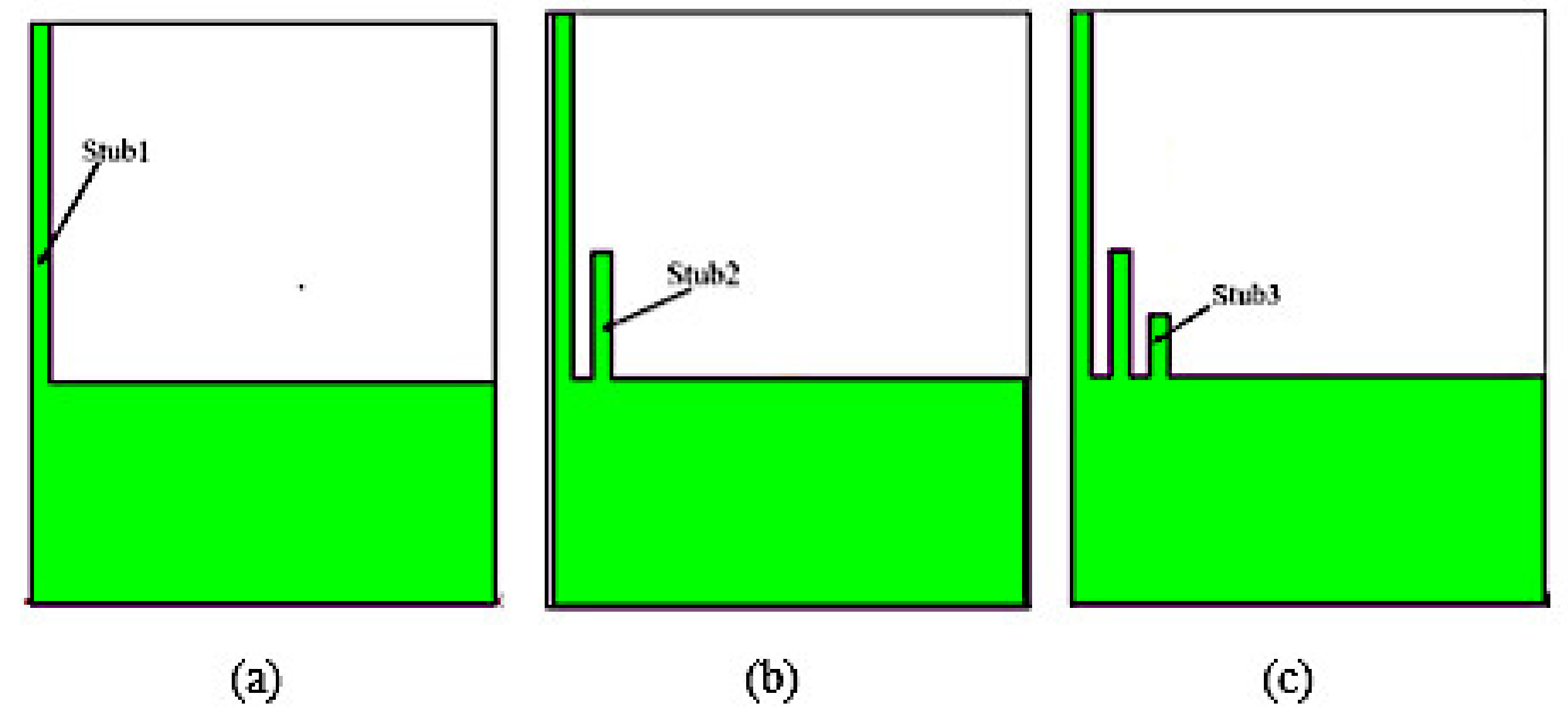
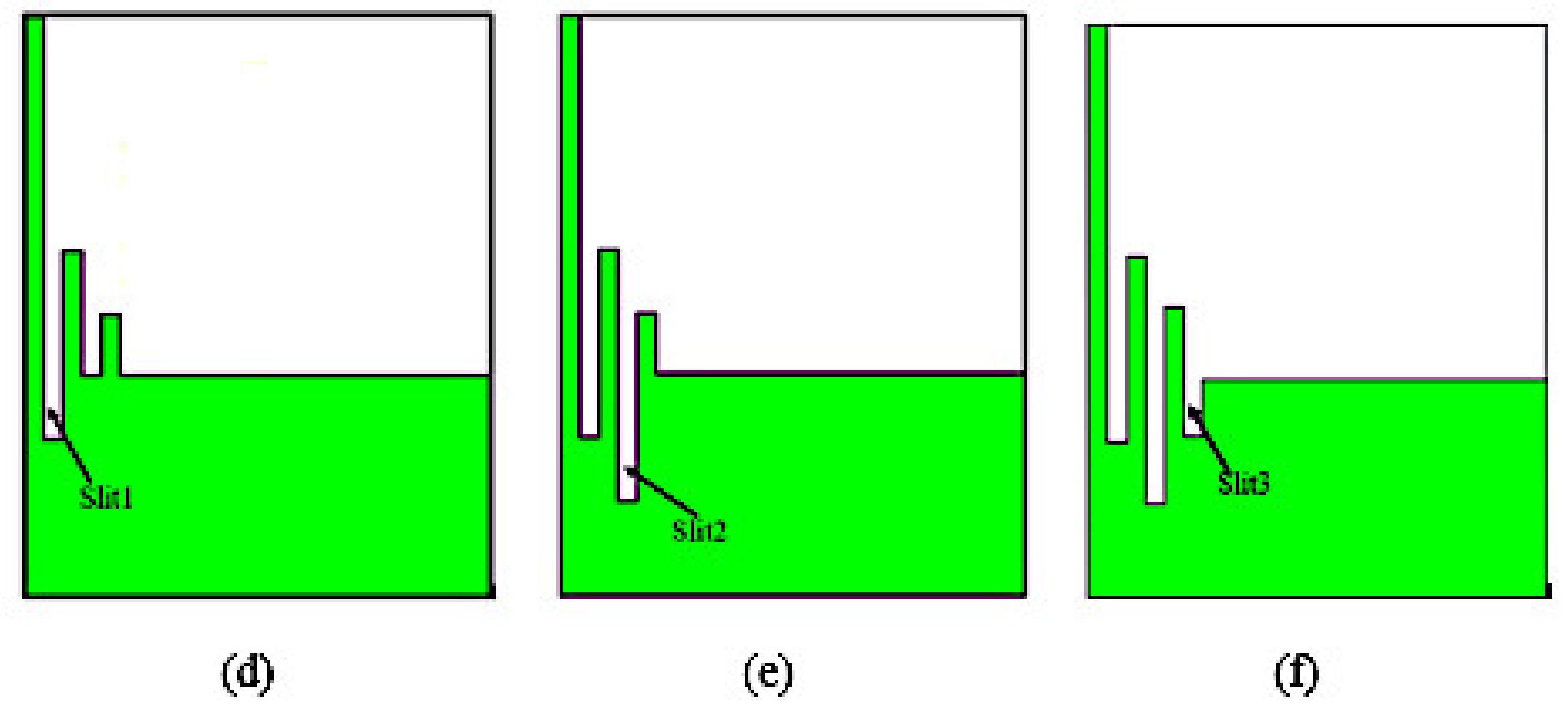
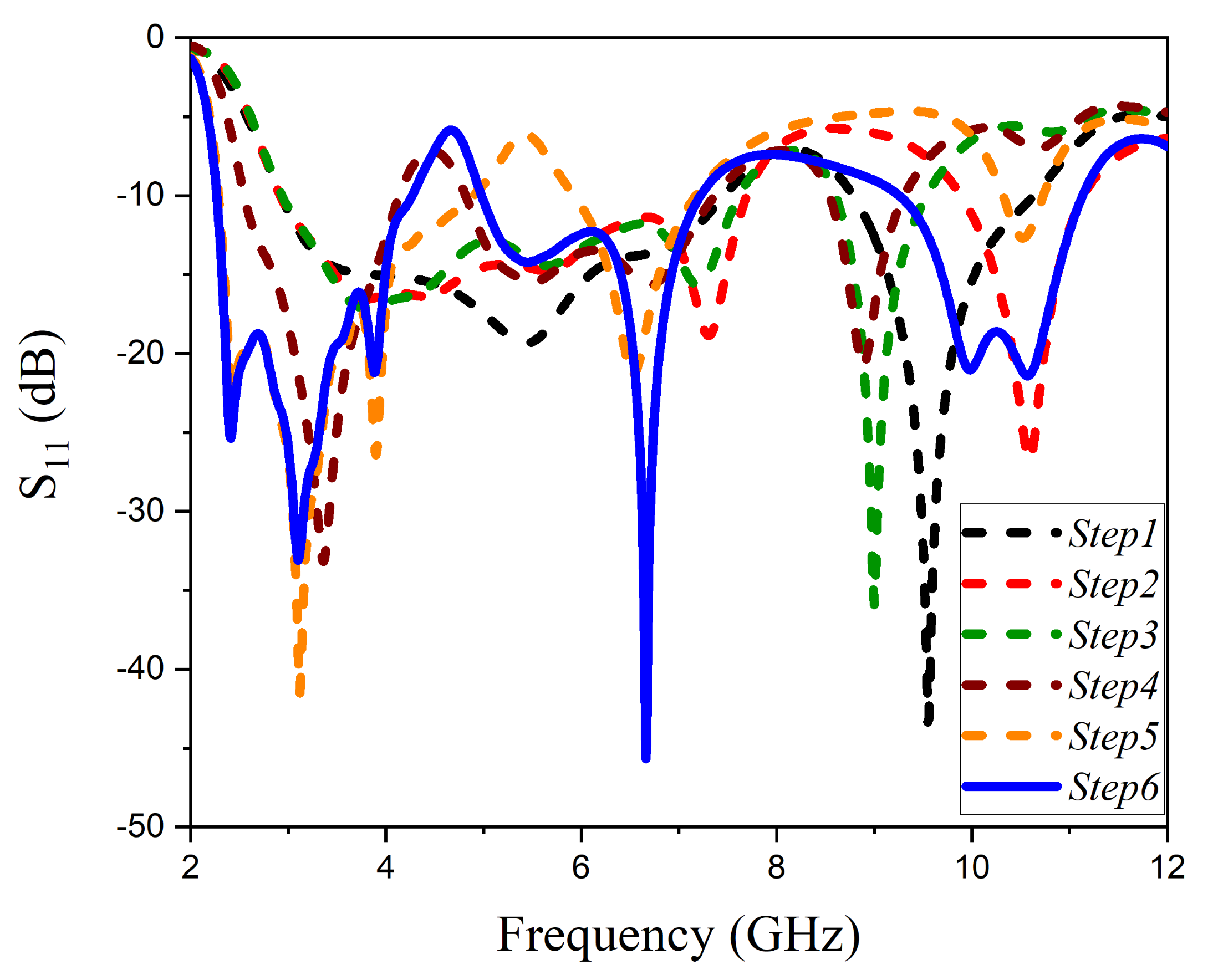
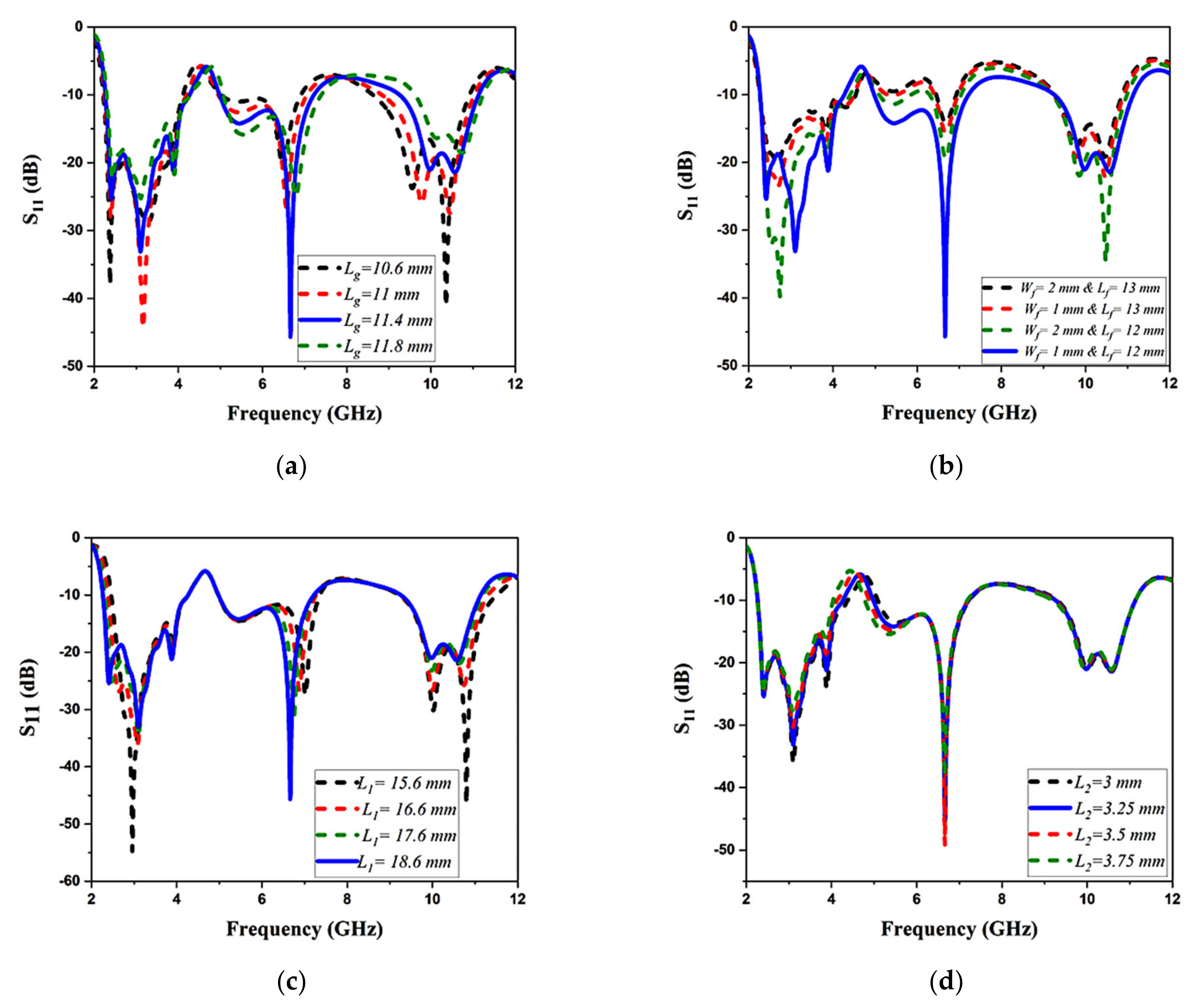
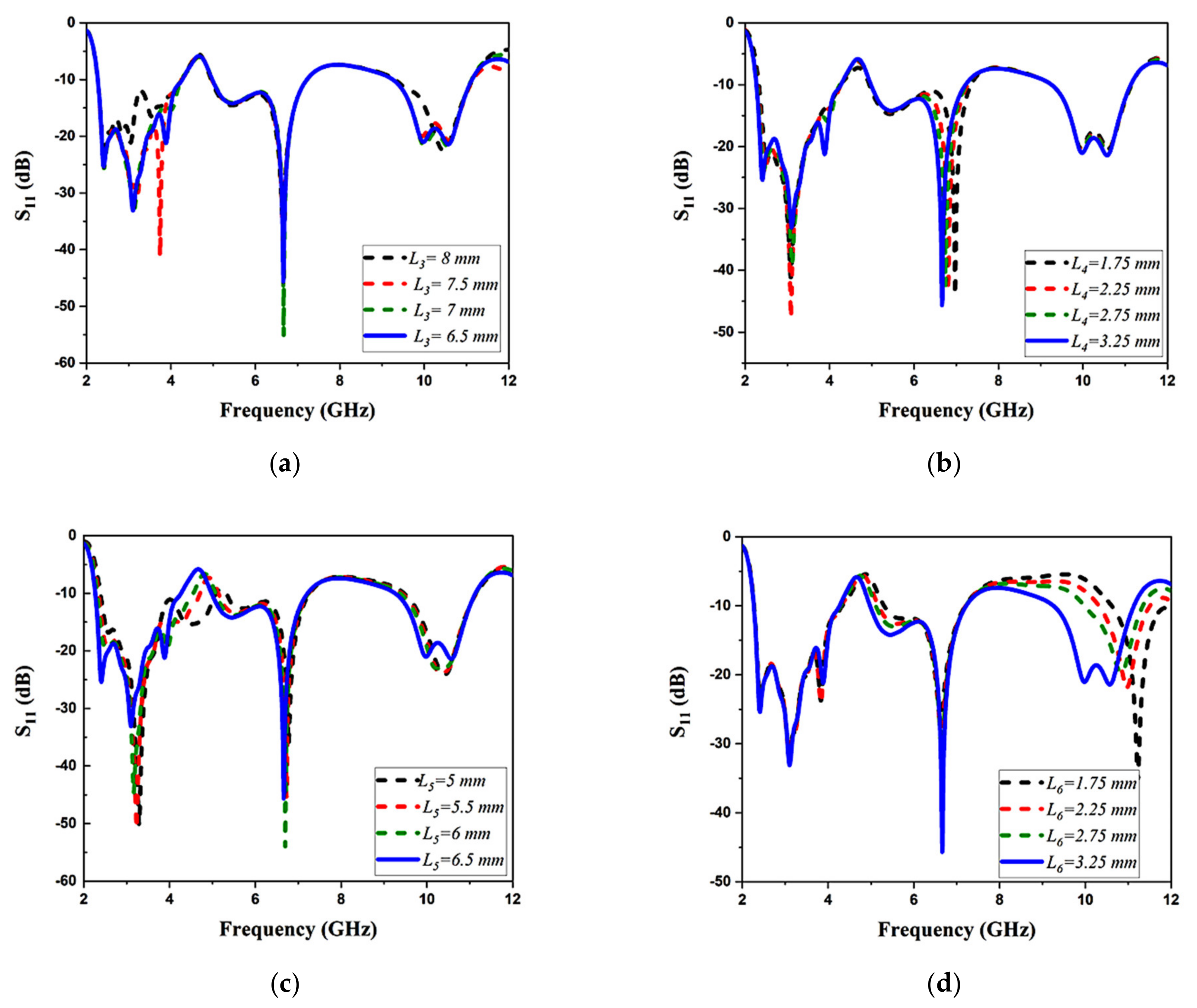

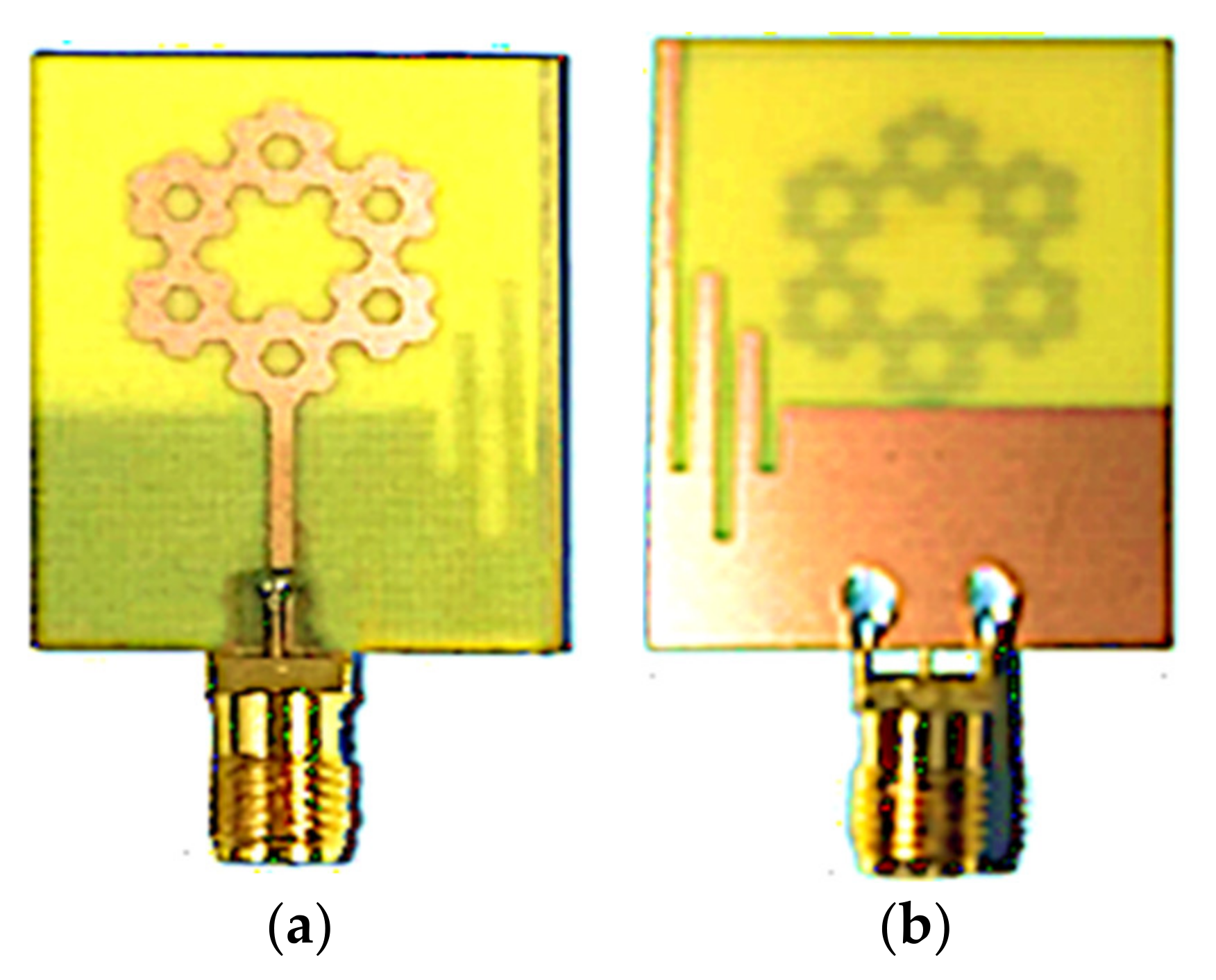
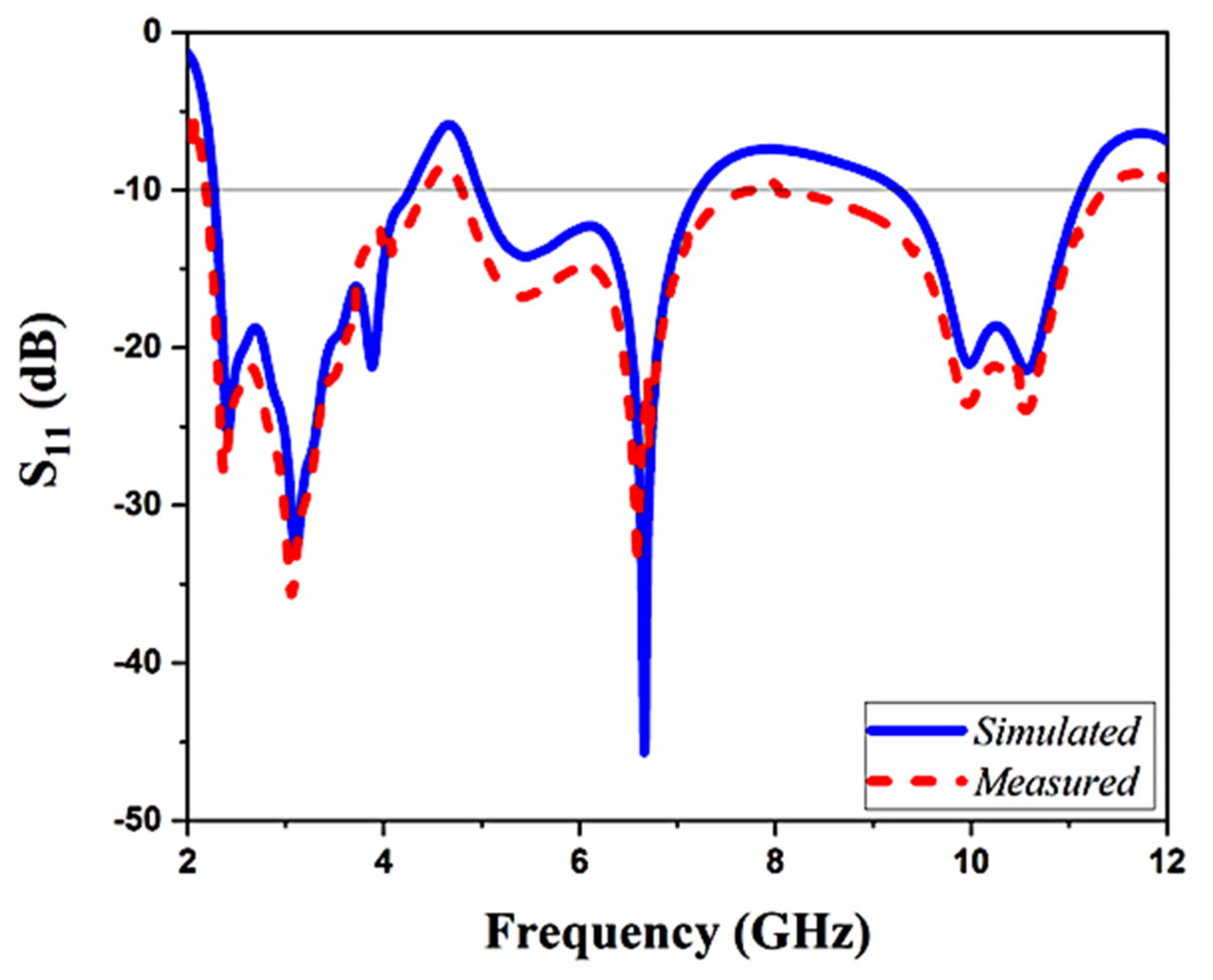

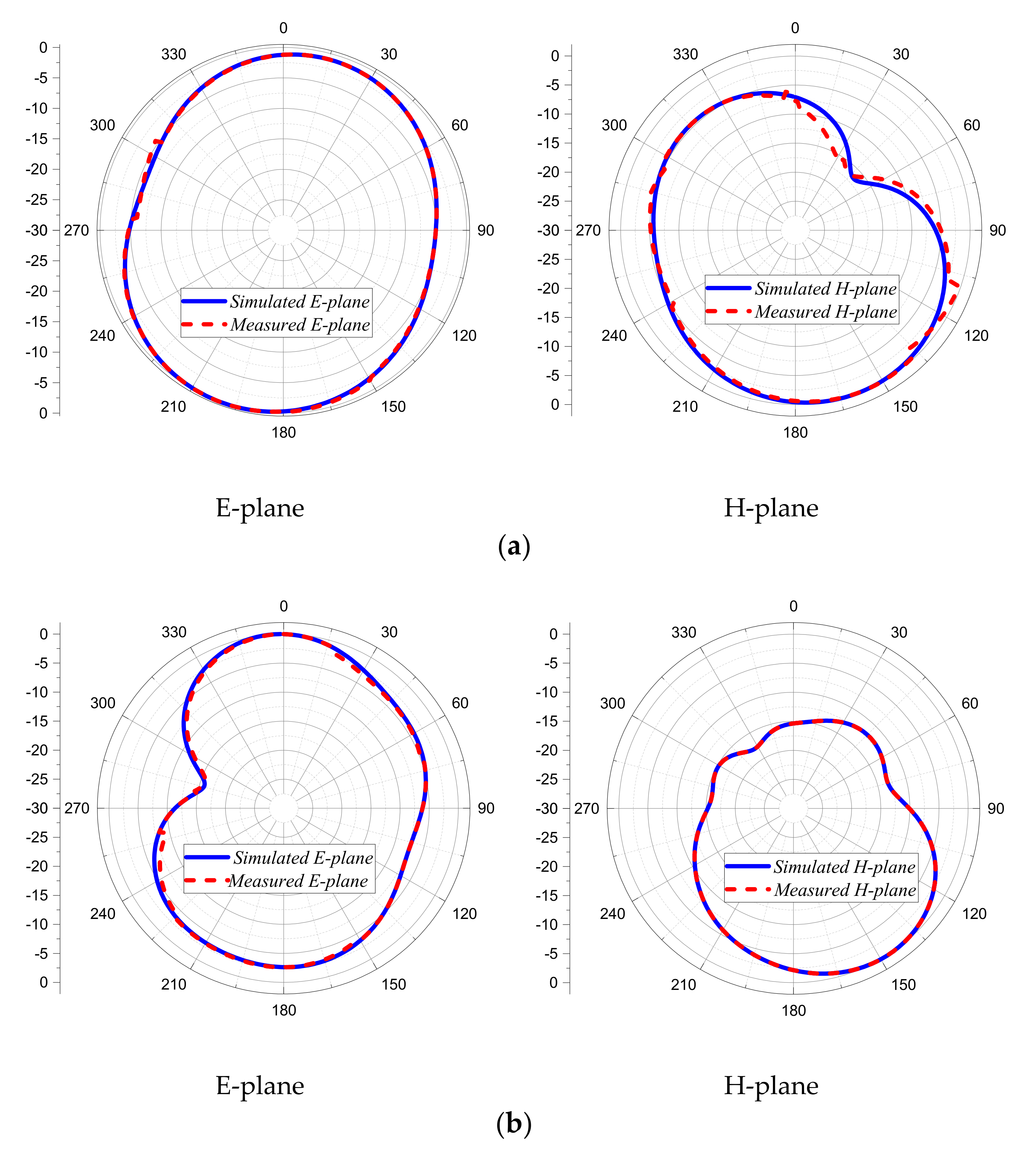

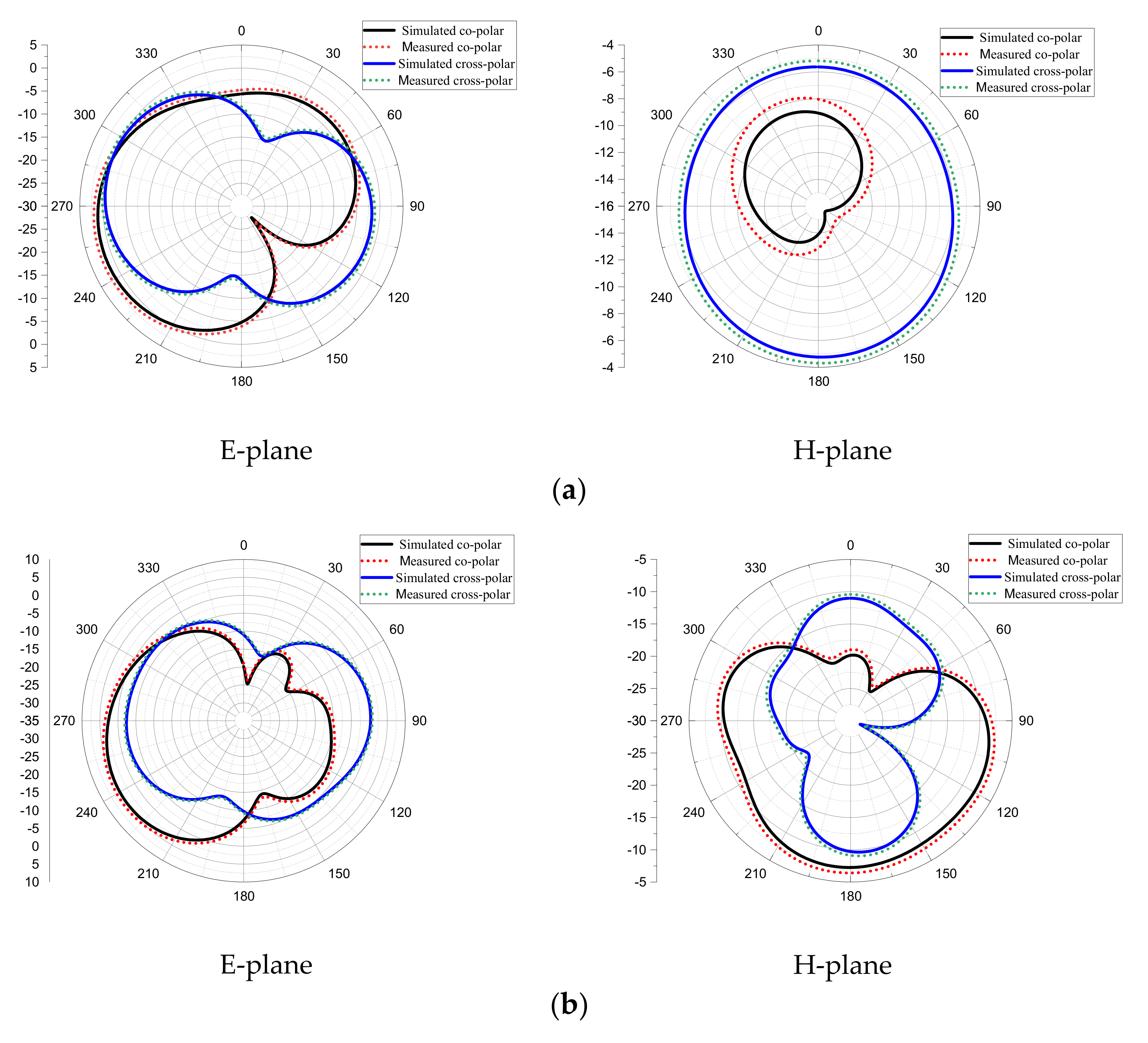

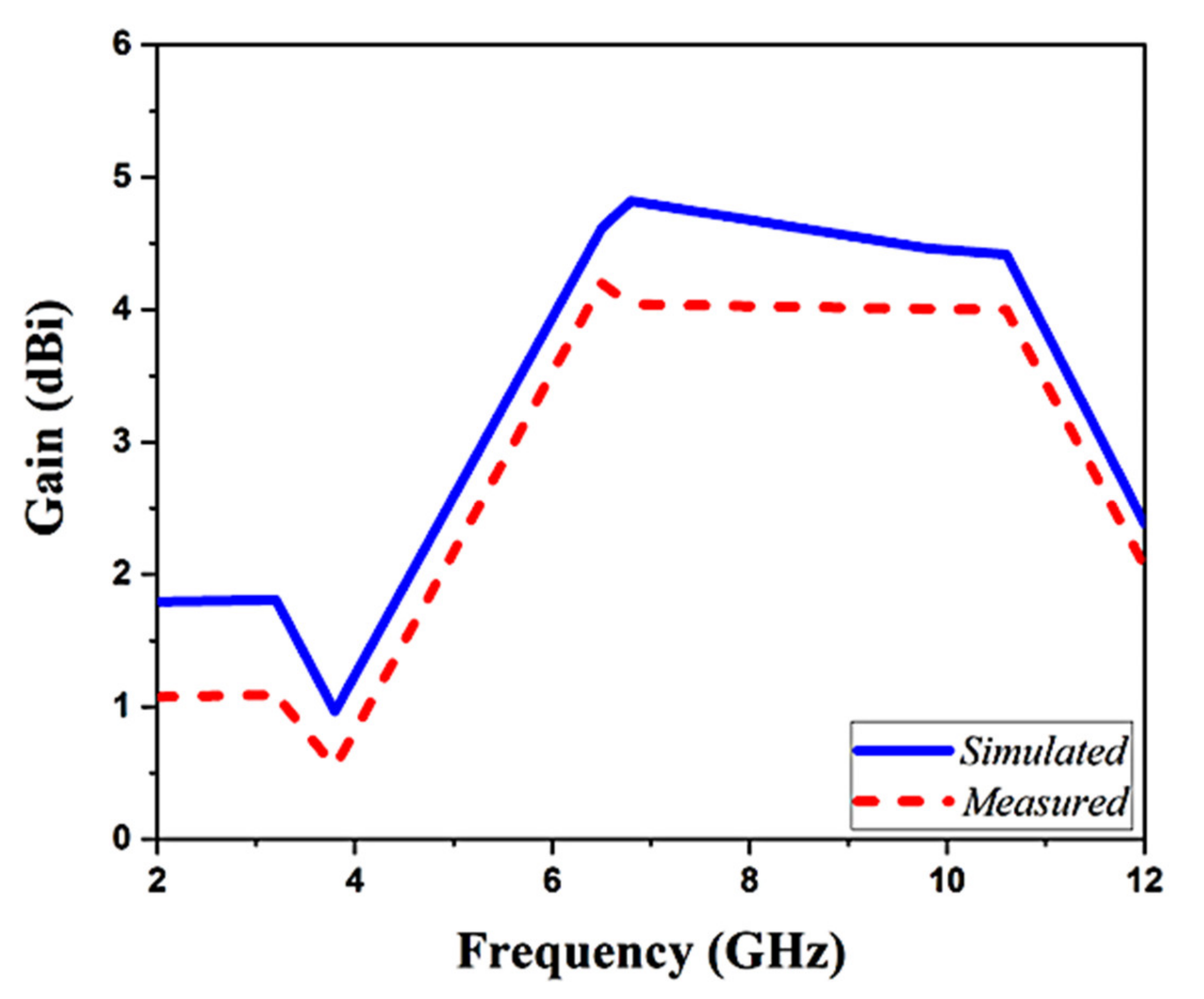
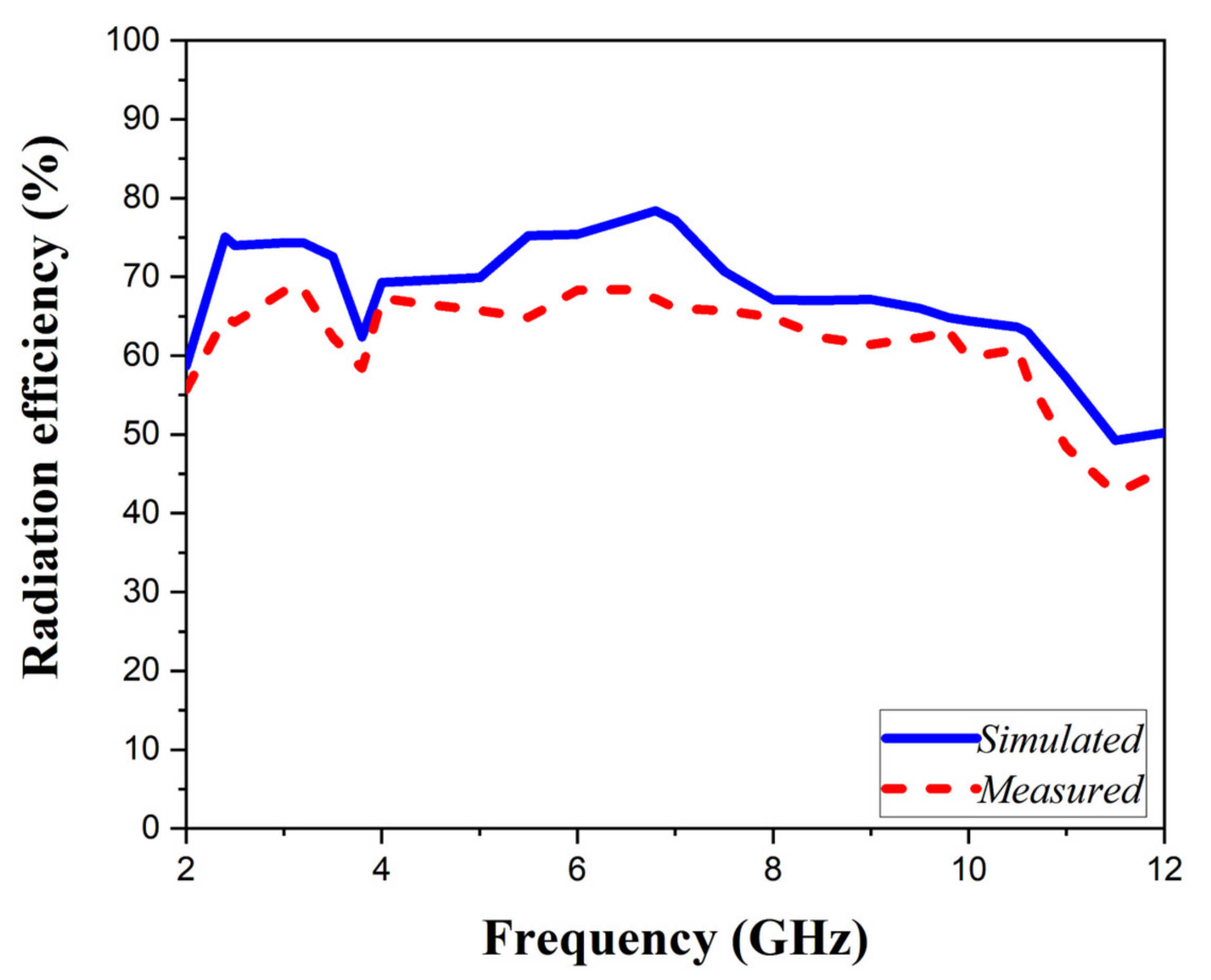
| Parameters | Dimensions (mm) | Parameters | Dimensions (mm) |
|---|---|---|---|
| L | 30 | L2 | 3.25 |
| W | 24 | W2 | 1 |
| h | 1.6 | L3 | 6.5 |
| h1 | 0.035 | W3 | 1 |
| Lf | 12 | L4 | 3.25 |
| Wf | 1 | W4 | 1 |
| S | 1 | L5 | 6.5 |
| Lg | 11.4 | W5 | 1 |
| L1 | 18.6 | L6 | 3 |
| W1 | 1 | W6 | 1 |
| Resonant Frequency | Reflection Coefficient | Operating Band | |
|---|---|---|---|
| Iteration 0 | fr1 =3.44 GHz fr2= 8.89 GHz | S11 = −11.12 dB S11 = −22.17 dB | 3.12–3.89 GHz 7.65–9.89 GHz |
| Iteration 1 | fr1= 3.6 GHz fr2= 6.77 GHz | S11 = −15.64 dB S11 = −22.08 dB | 2.99–8.77 GHz |
| Iteration 2 | fr1 = 3.6 GHz fr2 = 10.8 GHz | S11 = −19.73 dB S11 = −12.40 dB | 2.89–8.09 GHz 10.52–11.147 GHz |
| Developed antenna | fr1 = 2.4 GHz fr2 = 3.1 GHz fr3 = 3.9 GHz fr4 = 5.5 GHz fr5 = 6.66 GHz fr6 = 9.98 GHz fr7 = 10.57 GHz | S11 = −25.37 dB S11 = −32.98 dB S11 = −21.01 dB S11 = −14.2 dB S11 = −45.7 dB S11 = −21.02 dB S11 = −21.42 dB | 2.26–4.3 GHz 4.9–7.3 GHz 9.27–11.147 GHz |
| Simulated (CST) | Measured | |
|---|---|---|
| fr | 2.4 GHz 6.66 GHz 9.8 GHz | 2.41 GHz 6.59 GHz 9.8 GHz |
| Operating band | 2.26–4.3 GHz 4.9–7.3 GHz 9.27–11.147 GHz | 2.19–4.43 GHz 4.8–7.76 GHz 8.04–11.32 GHz |
| Gain | 1.71 dBi 4.61 dBi 4.46 dBi | 1.074 dBi 4.19 dBi 4.01 dBi |
| Efficiency | 75% 78% 68% | 68.35% 64.15% 62.7% |
| Ref. | Substrate | Size (mm3) | Resonant Frequency (GHz) | Operating Band (GHz) | Gain (dBi) | Antenna Design |
|---|---|---|---|---|---|---|
| [2] | FR-4 | 50 × 50 × 1.6 | 3.6; 5.3 | (2.48–6.7) | 2.78; 5.32 | Octagonal antenna with Vicsek fractal slots |
| [5] | FR-4 | 20 × 35 × 1.6 | 2.4; 3.8; 5.5 | (2.36–2.45); (3.2–6.29) | 1.5; 1.8; 3.38 | CPW rectangular antenna with elliptical slot |
| [9] | FR-4 | 61 × 87.5 × 1.6 | 2.5; 3.8; 5.3 | (1.8–2.9); (3.4–4.6); (5–5.6) | 3.33; 0.38; 0.57 | Sierpinski gasket fractal antenna |
| [10] | FR-4 | 40 × 40 × 1.6 | 3.8; 5.66; 8.3 | (3.86–3.94); (5.96–7.38); (8.2–8.9) | 0.1–0.2 1.9–2.8 0.1–2.8 | Sierpinski carpet fractal antenna |
| [16] | FR-4 | 32 × 40 × 1.6 | 2.4; 3.1; 4.5; 6 | (2.34–2.52); (3.07–3.59); (4.17–6.26) | 1.6; 2.15; 2.75; 3.8 | Annular ring-shaped fractal antenna |
| [18] | FR-4 | 32 × 32 × 1.6 | 3.5; 5.8; 7.4 | (3.265–8.2) | - | Hexagonal Koch fractal antenna |
| [29] | FR-4 | 59 × 51 × 1.575 | 3.68; 4.72 | (3.43–4.85) | 6.3; 8.3 | Bow-shaped fractal with SRR antenna |
| [30] | FR-4 | 34 × 34 × 1.6 | 2.4201; 5.802 | (2.35–2.5); (5.74–5.85) | 2.19; 5.74 | Giuseppe Peano and Cantor Set fractal-shaped antenna |
| [31] | Rogers RT5880 | 30 × 30 × 0.508 | 2.4; 5.8; 27.5 | (2.46–2.49); (5.0–6.3); (23–28) | 3.55; 4.72; 5.85 | Slotted conical antenna |
| [32] | FR-4 | 6 × 4 × 1.6 | 2.4; 5 | (2.37–2.53); (4.9–5.9) | 3.05; 6.4 | Maze-shaped monopole antenna |
| [33] | FR-4 | 60 × 50 × 1.6 | 1.8; 3.5; 5.4 | (1.73–1.86); (3.4–3.54); (5.2–5.45) | 2.22; 5.18; 1.38 | Two F-shaped monopole antennas |
| [34] | FR-4 | 30 × 30 × 0.8 | 5.5 | (4.8–5.9) | 2.5 | L-shaped monopole and J-shaped DGS |
| [35] | FR-4 | 36.4 × 36.4 × 1.6 | 2.4 | (2.33–2.54) | 3.45 | Slotted square antenna |
| This work | FR-4 | 24 × 30 × 1.6 | 2.41; 6.59; 9.8 | (2.19–4.43); (4.8–7.76); (8.04–11.32) | 1.074; 4.19; 4.01 | Sierpinski hexagonal-shaped antenna |
Disclaimer/Publisher’s Note: The statements, opinions and data contained in all publications are solely those of the individual author(s) and contributor(s) and not of MDPI and/or the editor(s). MDPI and/or the editor(s) disclaim responsibility for any injury to people or property resulting from any ideas, methods, instructions or products referred to in the content. |
© 2023 by the authors. Licensee MDPI, Basel, Switzerland. This article is an open access article distributed under the terms and conditions of the Creative Commons Attribution (CC BY) license (https://creativecommons.org/licenses/by/4.0/).
Share and Cite
Benkhadda, O.; Saih, M.; Ahmad, S.; Al-Gburi, A.J.A.; Zakaria, Z.; Chaji, K.; Reha, A. A Miniaturized Tri-Wideband Sierpinski Hexagonal-Shaped Fractal Antenna for Wireless Communication Applications. Fractal Fract. 2023, 7, 115. https://doi.org/10.3390/fractalfract7020115
Benkhadda O, Saih M, Ahmad S, Al-Gburi AJA, Zakaria Z, Chaji K, Reha A. A Miniaturized Tri-Wideband Sierpinski Hexagonal-Shaped Fractal Antenna for Wireless Communication Applications. Fractal and Fractional. 2023; 7(2):115. https://doi.org/10.3390/fractalfract7020115
Chicago/Turabian StyleBenkhadda, Omaima, Mohamed Saih, Sarosh Ahmad, Ahmed Jamal Abdullah Al-Gburi, Zahriladha Zakaria, Kebir Chaji, and Abdelati Reha. 2023. "A Miniaturized Tri-Wideband Sierpinski Hexagonal-Shaped Fractal Antenna for Wireless Communication Applications" Fractal and Fractional 7, no. 2: 115. https://doi.org/10.3390/fractalfract7020115
APA StyleBenkhadda, O., Saih, M., Ahmad, S., Al-Gburi, A. J. A., Zakaria, Z., Chaji, K., & Reha, A. (2023). A Miniaturized Tri-Wideband Sierpinski Hexagonal-Shaped Fractal Antenna for Wireless Communication Applications. Fractal and Fractional, 7(2), 115. https://doi.org/10.3390/fractalfract7020115









